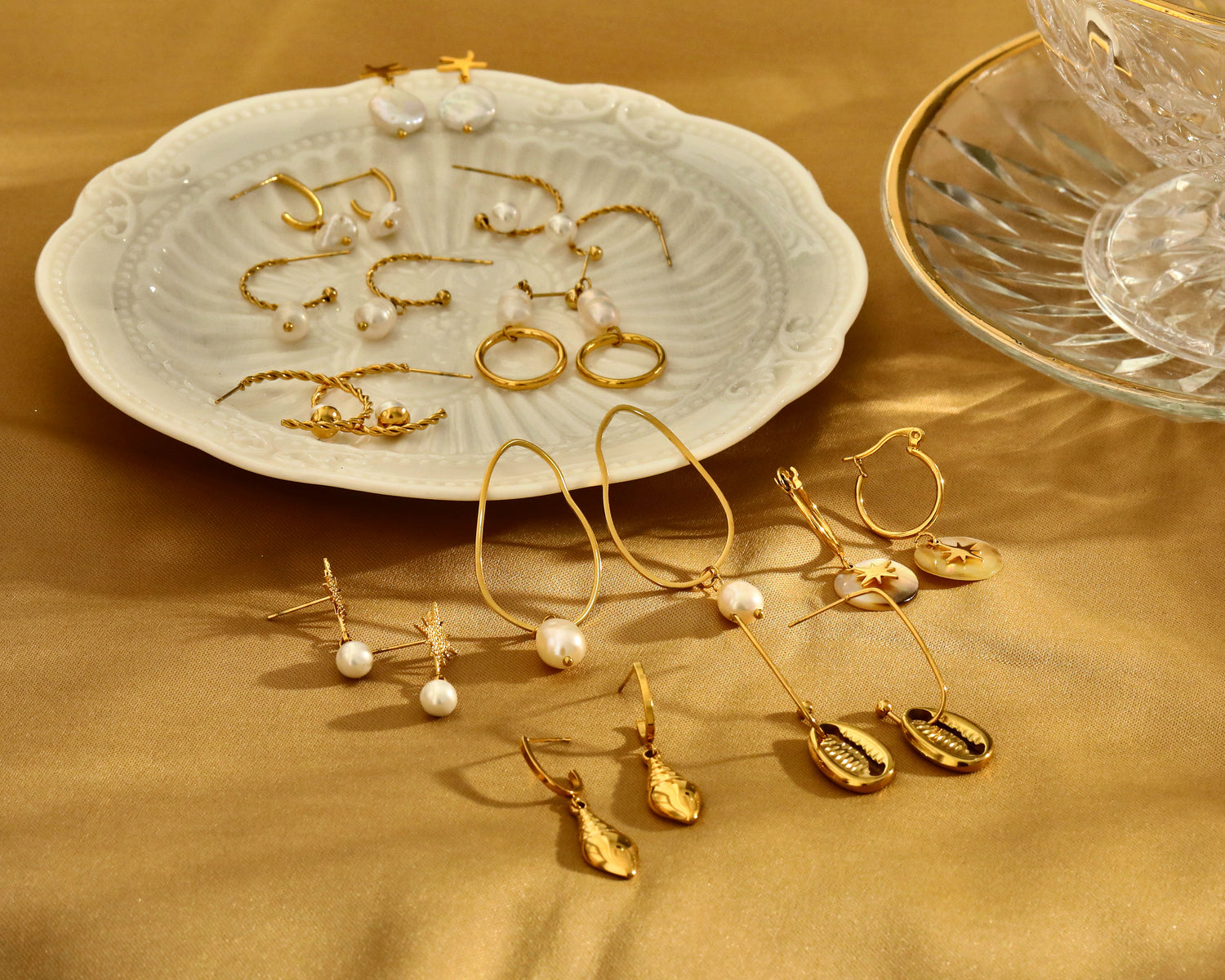ALLERGIC REACTION TO JEWELLERY?
Not only are nickel allergies incredibly common, they can also appear out of nowhere. You can wear a necklace for years only to develop symptoms suddenly and without warning. Once a metal allergy appears, it is typically with you for life. There is no way to predict who will experience the reaction.

KNOW YOUR METALS - ALLERGY FREE JEWELLERY
When it comes to jewellery, the type of metal used in the jewellery is important. Ordinary Stainless Steel is out since it can contains nickel, but surgical grade, such as 316L, is good. Silver should be Sterling 925, meaning it's over 90% pure. Anything less than 90% silver will have nickel, When choosing gold, go for 18K or higher. Titanium and Platinum are also non-allergic. Avoid white gold, as nickel is commonly mixed into the alloy to bring out the "whiteness" of the metal.
If you go for copper or brass jewellery, ensure that it is nickel free, especially for pierced pieces, and in particular the posts and needles. For added safety look for posts or needles made out of 316L stainless steel. Always check with the store or the online vendor to make sure.
Be cautious when buying jewellery termed hypoallergenic. It has no medical or legal reference. Companies are free to label their jewellery hypoallergenic without any regulation. When you do see the term being used check the details and ask the company what makes the item hypoallergenic. Rather than looking for jewellery marked hypoallergenic, learn about allergy safe metals, and specifically look for these particular metals when shopping for jewellery.
At HACKNEY NINE we do not use any nickel in our jewellery. All our items are made out of surgical grade 316L Stainless Steel. Our gold layered jewellery is doubled dipped in 18k pure gold for longer wear, and is also produced nickel free. All the metals that we use are deemed to be non-allergic for the large majority of wearers.
SKIN TURNING GREEN?
Some people find that copper and brass jewellery can turn their skin green. This not an allergic reaction. It is oxidation which is safe, but not pleasant looking. See "Why some jewellery turns your skin green and how to avoid it"
PIERCINGS

Jewellery worn through pierced areas holds more risks for both infection and allergic reactions. Absolutely avoid any jewellery piece containing nickel, particularly in the posts and needles.
Most body piercing jewellery consists of rings, hoops, studs, or barbell-shaped ornaments. The size and shape of jewellery is determined by the body site pierced and personal preferences. Jewellery is not always interchangeable between piercing sites. In particular, jewellery designed for ear piercing may not be suitable for another part of the body because of the length of the post or the pressure exerted by the clasp.
It is equally important to ensure that your piercing is done safely. If not, an infection can result.
Be thorough about the following:
- Who does the piercings? Don't attempt to pierce yourself or allow an untrained friend to do the piercing. Go to a reputable piercing studio where employees are properly trained.
- Regulation requirements and licensing standards vary from state to state. Check with your city, county or state health department for information on local licensing and regulations.
- Does the piercer wear gloves? Make sure the piercer washes his or her hands and wears a fresh pair of disposable gloves for each piercing.
- Does the piercer use proper equipment? While some venues use piercing guns for earlobe piercing, the Association of Professional Piercers cautions that reusable piercing guns can't be properly sterilized and can damage ear tissue. For earlobe and other body piercings, look for a piercer who uses a fresh, sterile, disposable needle to create a hole and then inserts a suitable piece of jewellery into it.
- Does the piercer sterilize non-disposable equipment? Make sure the piercer uses a heat-sterilization machine (autoclave) to sterilize all non-disposable equipment after each piercing.
After the piercing be sure to take good care of it. The skin around a new piercing might be swollen, red and tender for a few days. It might bleed slightly. You will usually know if your piercing becomes infected if the surrounding tissue becomes red, painful, swollen and warm to the touch, or if you get discharge that is dark yellow, greenish, bloody, or has a bad odor. A small, fluid-filled “pimple” will often accompany facial piercing infections. If you do suspect an infection, do not remove your jewellery. Infections are more easily treated if there is still an opening for antiseptics to enter the wound and for discharge to exit. Without jewellery, the surface of the wound closes over and traps the infection inside, often causing a local surface infection to become a more generalized one. If the swelling, redness and bleeding last longer than a few days, contact your doctor. Prompt treatment can help prevent potentially serious complications.
PIERCING AFTERCARE
Cleaning Solutions: Packaged sterile saline (with no additives, read the label) is a gentle choice for piercing aftercare. If sterile saline is not available in your region a sea salt solution mixture can be a viable alternative. Dissolve 1/8 to 1/4 teaspoon (.75 to 1.42 grams) of non-iodized (iodine-free) sea salt into one cup (8 oz / 250 ml) of warm distilled or bottled water. A stronger mixture is not better; a saline solution that is too strong can irritate the piercing.
Cleaning Instructions for Body Piercings
- Wash your hands thoroughly prior to cleaning or touching your piercing for any reason.
- Saline rinse as needed during healing. For certain placements it may be easier to apply using clean gauze saturated with saline solution. A brief rinse afterwards will remove any residue.
- Rinse thoroughly to remove all traces of the soap from the piercing. It is not necessary to rotate the jewellery through the piercing.
- Dry by gently patting with clean, disposable paper products because cloth towels can harbour bacteria and snag on jewellery, causing injury.
- Clean oral piercings with mouthwash. If you've had your tongue, lip or cheek pierced, rinse with an alcohol-free, antiseptic mouthwash after each meal and before you go to bed. After your piercing, use a new soft-bristled toothbrush to avoid introducing bacteria into your mouth. Once the area has healed, take the piercing out at night and brush it to remove plaque. Consider taking it out when eating or during strenuous activity, as well.
- Clean skin piercings. If you've had your skin pierced, clean the site twice a day with soap and water. Be sure to wash your hands before cleaning your piercing site.
- Avoid swimming. Stay out of pools, hot tubs, rivers, lakes and other bodies of water while your piercing is healing.
- Don't fiddle with your piercings. Don't touch a new piercing or twist the jewellery unless you're cleaning it. Keep clothing away from the piercing, too. Excessive rubbing or friction can irritate your skin and delay healing.
- Keep the jewellery in place. Most piercings heal within about six weeks, but some might take several months or longer to heal. To maintain the piercing, leave the jewellery in place during this time, even at night, to keep the hole from closing.
AVOID LEAD & CADMIUM
Lead is often used in jewellery, to make the article heavier, brighten colors, and to stabilise alloys. However, lead can be dangerous, even deadly. It is a toxic metal, which doesn’t break down in the environment and accumulates in the body. Exposures to lead can result in a number of health problems, including; behavioural problems, learning disabilities, joint and muscle weakness, anemia, organ failure, and eventually even death.
Cadmium in jewellery is also a serious danger to health. Ingesting or breathing it can lead to kidney dysfunction and osteoporosis according to the US Centers for Disease Control and Prevention’s Agency for Toxic Substances and Disease Registry. The metal poses a heightened risk when it’s used in children’s jewellery because kids are in the habit of absentmindedly putting things in their mouths, which is one of the easier ways to get it into your system. Adults are still at risk when they touch their jewellery and then eat something with their unwashed hands.

